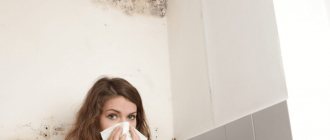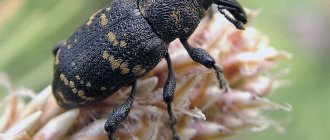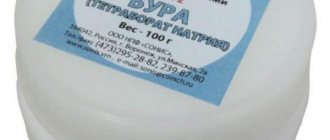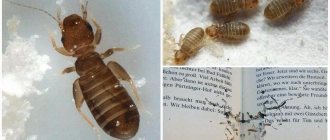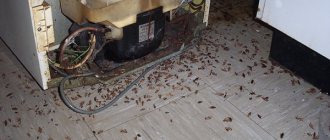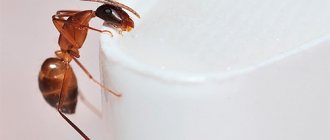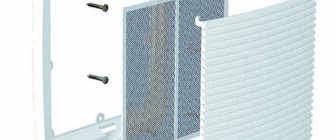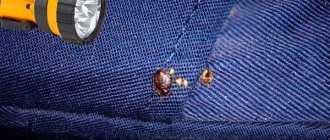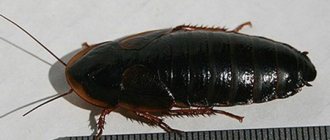Photo and description of woodlice: what does it look like and what is its structure?
Calling woodlice an insect or beetle is completely incorrect. They are crustaceans, essentially tiny crustaceans. Their appearance has the following features:
- An oval, convex body at the top, covered with hard, hard shields, like an armadillo. In our country there are gray and light gray woodlice with a greenish tone. The standard size of mature individuals is 0.5–1.5 cm. 2 cm is the longest length of the common woodlice.
- 2 pairs of antennas consisting of several segments. The first pair of antennae, in contrast to the second, are small and poorly developed. Based on the fracture and length of the woodlice's nests, their belonging to one species or another is determined.
- The eyes are located on the sides of the head.
- Mandibles lack tentacles.
- Eight thoracic segments, the first of which covers the sides of the head, the last has a deep notch at the back.
- 7 pairs of legs adapted for movement. The first 5 pairs of legs cover each other like tiles. Their inner branch serves as gills, and the outer branch serves as a lid. The solid outer branch of the first pair of limbs contains air cavities that open outward. The sixth pair of legs is turned backward and protrudes between the fifth and sixth abdominal segments.
Woodlice are quite large in size, so they are easy to notice if they have settled in the house. You can see what these creatures look like in the photo. Below is also a diagram of their structure.
How does it reproduce?
When the crustaceans reach normal conditions for procreation, and this happens mainly in April and May, they lay eggs. This process mainly takes place at night.
- When a male meets a sensitive female, he climbs onto her back and “drums” on her with his front paws and at the same time “licks” her head with his mouthparts.
- During movement, the male does not leave the female, transferring his seed to one of several genital openings of the female.
- Then he moves to the other side and continues the process into the other genital opening.
- During the breeding season, reproductive females create what is called a "brood pouch", somewhat similar to a cockroach's brood pouch, consisting of overlapping leaf-like structures known as "ostegites". Fertilized eggs pass into this fluid-filled chamber, and after hatching, the young crawl out of the brood pouch when fully developed.
How does he breathe?
Even though this creature lives on land, it breathes exclusively through gills. The air that woodlice breathes must be moist.
What does it eat?
These creatures love to enjoy a variety of delicacies for them. They prefer to eat rot and already dead plants, but can also eat living ones.
REFERENCE! In addition, they prefer leaves or other organic remains. Also, do not neglect to eat dust and mucus on the walls.
How many legs does a woodlice have?
An adult woodlice has 7 pairs of legs , and a larva has 6 pairs .
You can examine the woodlice in detail only by taking a photo using macro photography. Then it becomes clear that it really is very similar to crustaceans. Not only is it covered with chitinous scutes, which is not observed in insects, but it also has seven pairs !
woodlouse
Many people, and let’s be honest, some time ago I too, have an innate aversion to small multi-legged creatures. This multitude of translucent moving legs in two rows must have caused disgust at the genetic level, because in prehistoric times these creatures were much larger and mostly poisonous. Such organisms definitely include centipedes, and somewhat similar, but not related, pintails, cockroaches and woodlice. The latter will be discussed today. This is one of the few crustaceans (woodlice are not insects!) that have mastered the land lifestyle and spread almost throughout the world. Woodlice (lat. Oniscidea) belong to the class of higher crayfish , order of isopods (Isopoda).
90% of people are absolutely sure that woodlice is an insect, and the number of legs does not bother them at all. So, in fact, woodlice is a crustacean! That is, in terms of kinship it is much closer to shrimp or lobster than to a cockroach. Insects always have 6 legs, and woodlice have 7 pairs of them!
Their blood is blue and they still breathe using gills. The gills are attached to paired pleopods (literally, “swimming legs”) on the animal’s abdomen and contain an extensive network of moist tube vessels that allow oxygen to be extracted from the air, although the woodlice can remain calm in water for about an hour.
You can meet woodlice on the wall of a basement or a rotten tree trunk. But as soon as you disturb her, she instantly disappears into a hole located nearby. If you block the path of a woodlouse, it will curl up into a ball and roll head over heels into the grass - this is the only defense of the land cancer.
Woodlice is the most terrestrial crustacean. And this is probably its main feature. Of all crustaceans, woodlice are the best adapted to life on land. Particularly distinguished in this regard is the desert woodlice, which, as the name suggests, lives in the desert. Some species of woodlice continue to live underwater.
Existing on land, woodlice still breathe with gills adapted to breathing atmospheric air. High humidity is required for their normal operation. This explains the woodlice’s extreme dislike of light and their nocturnal lifestyle. The same thing, but in scientific language it will sound like this: “woodlice are negatively phototropical.”
Wood lice feed on various kinds of organic remains, mainly rotten wood, and therefore they nest in large numbers under the bark of old trees and in other dark, damp places (remember the English name - tree lice). In homes they prefer basements, secluded corners in bathtubs and toilets, various kinds of risers and communications.
In English, woodlice is called woodlouse, which literally translates as “wood louse.” What other nicknames did the British give them! Sow bugs, ball bugs, armadillo bugs, slaters, chiggy pigs, cheeselogs, bibble bugs , cud worms, coffin cutters, monkey peas, pea bugs, granny-ants, Billy Bakers. The Czechs call them “pigs” and “earplugs,” while the Dutch simply call them pissebed (literally: “peeing in the bed”). This is because woodlice do not urinate: thanks to their porous shell, secretions are removed from their bodies in the form of ammonia vapor, and not in the form of liquid urine. For their size, woodlice produce more nitrogen-containing waste than any animal on the planet.
The porous shell also means that woodlice cannot accumulate and retain water in their tissues for a long time. Their tendency to huddle in large groups helps conserve moisture and protects them from predators. Shrews, toads, centipedes - all this trinity loves to feast on woodlice. The larvae of carrion flies gnaw passages in the woodlice's shell and eat the animal from the inside. The spider Dysdera crocata feeds exclusively on the flesh of woodlice: its fangs are specially adapted to pierce the shell of these crustaceans.
The sex life of woodlice has interesting features. Unfertilized females have a pair of holes on the ventral side of the fifth thoracic segment leading into the spermatic receptacles, with the blind end facing the oviducts. During copulation (in April or May), the receptacles are filled with seed; after some time they burst at the inner end, and the seed enters the oviduct. Following this, the female molts and is significantly changed: the paired genital openings of the fifth segment are closed, and instead of them an unpaired slit-like opening is formed on the border between the 5th and 6th segments; on the first five pairs of legs, plates are formed at the base, constituting the brood chamber.
The seed then penetrates the ovary, and the fertilized eggs exit through the aforementioned unpaired opening into the brood chamber, where they develop. Part of the seed remains unclaimed and fertilizes a new clutch that enters the bag after the generation hatched in it leaves it. When the new generation develops and leaves the pouch, the female sheds her skin again and appears after molting in its original form.
Woodlice actually drink through their butts. Small bifurcated tubes, or uropods (the last pair of limbs), suck moisture directly into the anus.
Woodlice are also not too picky when it comes to food. Their favorite food is rotting vegetation, but in a lean month they will also eat their own feces. In New Zealand, there is a species of seaside woodlice (Scyphax ornatus) that lives on sandy beaches and mainly feeds on the corpses of drowned bees. Woodlice's unusual personal habits make them indispensable for compost heaps, and their love of grinding up rot has earned them employment in paleontological museums around the world, where they happily polish the fragile skeletons of exhibit animals.
Woodlice live in all landscape zones, but they are especially numerous in the steppes. All woodlice are nocturnal, avoiding direct sunlight. They spend daytime in damp shelters under stones, buried in the soil, or in burrows that they dig themselves. Woodlice feed on plants, which they eat at night. Through plants, woodlice also obtain the water they need for breathing.
Woodlice is beneficial in nature because it mainly consumes decaying plant remains and plays a role in soil formation. Basically, its functions in the garden are approximately the same as those of earthworms, although in some cases it can harm particularly delicate plants, incl. eat a strawberry. Woodlice serves as food for many animals and insects. Due to this circumstance, it can be bred specifically to feed domestic reptiles, spiders and other pets.
Who can you confuse with?
Among the insects that resemble woodlice in appearance are the following:
- Crimean kivsyak is a millipede that lives in the south of Russia, usually disguises itself as woodlice and lives in cellars.
- Silverfish , woodlice is often confused with it. These insects have an elongated body that tapers from head to tail. At the back you can see three tails that look like thin hairs. Looking closely, it is easy to catch the resemblance to a fish fry. Silverfish are nocturnal, feed on organic substances: mold, wet paper, food waste, synthetic fiber, and even in times of famine they do not disdain dead fellows. They reproduce very slowly, unlike woodlice.
Attention! Woodlice process all kinds of waste like earthworms, benefiting the environment. They are also food for lizards, spiders, and toads.
Occasionally, at home, colonies of woodlice are specially grown and then used as food for exotic animals.
According to all the known facts about woodlice, we can conclude that they are not carriers of infections, do not damage furniture, do not eat food, are completely safe, do not bite humans, but rather try to stay as far away as possible. Of course, living in an apartment, they do not evoke sympathy. But before you start fighting, you should think about the benefits and harms of them. Perhaps the cause of their occurrence should be eliminated rather than trying to destroy completely harmless woodlice.
What does a woodlice look like?
Woodlice (Oniscidea) is a suborder of crustaceans from the order Isopoda. The woodlouse has an oval-shaped body, with a slightly convex upper part. The body consists of eight segments, the first wraps around the head, the last has a notch, and on the abdomen the segments are in a free position. The body of the woodlice is reliably protected by a dense shell.
The woodlice has two pairs of antennae on its head: one is weakly developed and the other is strongly developed. The eyes are located on the sides of the head. The woodlice has a jaw.
The woodlouse has seven pairs of legs, well adapted for walking. The internal branch of their body plays the role of gills, and the outer part is covered with a shell that protects the respiratory organs. When threatened, woodlice curl up into a ball.
Many people believe that woodlice is an insect. Indeed, in appearance and size it is similar to beetles, but in fact the woodlice belongs to the order of isopods, a suborder of crustaceans.
The lifespan of woodlice is 9-12 months.
In appearance, woodlice is similar to a centipede, which is why they are often confused. But if you can see the first one in the house, then the centipede usually lives in the wild, for example, under stones or in fallen leaves.
Stages of creature development
After some time, larvae emerge from woodlice eggs, but even after the larvae are born, they still live for some time in the so-called “brood chamber.” There they grow and develop for about forty or fifty days. The main difference between larvae and adult representatives of this class is that they have only twelve legs, while adults have fourteen. Before the adult stage, the larvae molt up to ten times. All these molting processes for woodlice larvae take approximately three months.
How do woodlice reproduce?
The mating period for woodlice falls in April-May. During the process of copulation, the male fills the female's testicle with seminal fluid. After some time, the testis bursts and the seed enters the oviduct. At this time, the female molts, which leads to changes in her appearance: the paired genital openings close, transforming into unpaired slits, and a brood chamber appears on the five front pairs of legs. Fertilized eggs enter it, where they begin to develop.
But not all of the seed is converted into eggs; a certain amount remains and participates in fertilization after the first generation is born.
Woodlice eggs hatch into larvae that develop in the brood chamber for 40-50 days. The larvae have 6 pairs of limbs. During their development, they experience 10-12 molts.
Woodlice larvae
The woodlice larva has an appearance that somewhat distinguishes it from adult crustaceans. First of all, she has only 6 pairs of legs , the seventh appears later. And the most important distinguishing feature of the larva is its color. After all, before becoming a full-fledged individual, she has to endure up to 10 molts .
It is not surprising that for this reason the larvae look mostly “transparent”. This continues for three months. By the way, it is customary for woodlice to look after younger individuals. They protect the young in case of approaching danger and help them reach food sources.
Features of the internal and external structure
On the head of the woodlice there are 2 antennas and eyes, which are located at the edges of the head. The exoskeleton is formed from the segments. He saves this creature from the adverse effects of the environment. No waxy cuticle. The respiratory organs are located under the paired plates.
They are internal plates - a respiratory organ or a type of gill, which is completely permeated with blood vessels. It is located under the abdominal legs, the plates hold moisture around the gills. The woodlice has seven pairs of legs, unlike its “relatives”.
Types of crustaceans
According to various sources, in nature there are 3500-5000 species of these small crustaceans: armadillidiidae (armadilla), porcellio scaber (porcella, or mumps), Reaumur woodlice, etc. The following types of woodlice can be found on the territory of our country:
- Common woodlouse armadillo. These owners of a dark, high shell are rarely found in residential areas. They usually live in basements and cellars.
- Woodlice is rough. This type of crustacean has a soft, flattened shell that is greyish, yellowish, reddish or almost black. Unlike the armadillo woodlice, the common woodlice moves quickly. They are able to deftly move between floors in apartment buildings. This woodlice can rightfully be considered domesticated.
Most varieties of these crustaceans, due to climate conditions, are not adapted to life in our country. While the rough woodlice does not require special conditions, the Reaumur woodlice lives exclusively in deserts and semi-deserts.
Where do woodlice come from?
Many people have encountered woodlice. Someone meets them while clearing out stale garbage from the site, and someone can see the crayfish when they go down to the cellar. They live under fallen leaves, in humus. They need moisture, woodlice in the apartment settle in places where dampness accumulates - the bathroom, toilet, kitchen, basement and attic. Excess moisture can accumulate in potted plants, which means the answer to the question of where woodlice appear in an apartment is obvious. In private houses they can be found after rain under a stone or brick.
If woodlice have settled in an apartment, how to get rid of them and where to look for habitats is a top priority. First of all, you need to inspect places where water accumulates, basements, baseboards in the kitchen, under the rug in the bathroom, under pipes, in closets with stale linen, on damp books, under the sink. Is there any leaking plumbing, or is there any garbage lying for a long time in a secluded place? They are often attracted to moist soil in flower pots.
Before you destroy wood lice in your apartment, you need to find out where they came from in order to block the paths of further spread.
In apartment buildings, insects often enter the premises through ventilation grilles, through sewer pipes; if they do not like the conditions (the room is dry), wood lice do not even linger in the bathroom or toilet, but go to look for the most favorable housing.
On the top floors, woodlice appear in the apartment, descending from the attic. Therefore, it is a good idea to check the attic space as well.
In a private home, close attention should be paid to greenhouses and greenhouses, where they end up with humus. In the cellar, the cause of their appearance may be rotten vegetables. In the garden - these are broken bricks, cuttings of branches, stones, rotting leaves. And in each case, the recipe for how to deal with woodlice is individual.
Where do woodlice come from in the house?
As mentioned earlier, woodlice prefer damp rooms. They start in damp attics, garages, basements, cellars and sewer channels. Then from there they can move to apartments, most often to those located on the first or last floors.
Woodlice grow in apartments where there are conditions suitable for them:
- excess moisture (for example, plumbing is leaking in the bathroom, the rooms are poorly ventilated);
- stagnant water in flower pots;
- dirty dishes in the sink;
- rotting garbage.
If you carefully monitor the cleanliness of your home and prevent the accumulation of moisture, dirty dishes and garbage, then the likelihood that woodlice will appear in your apartment is significantly reduced.
Why are wood lice dangerous in an apartment?
The destruction of woodlice in an apartment is an important undertaking. They do not bite animals or people, but if they are not removed, the consequences can be extremely dire.
It has been proven that wood lice in the house are carriers of various diseases; they spread lichen and fungus throughout the premises, thereby causing enormous damage to human health.
Many people feel disgust at just one glance at a repulsive and unpleasant insect, and constant contact with them, for example, if woodlice appear in the bathroom every time you turn on the light, can cause stress and a nervous breakdown.
Do woodlice bite?
The mouthparts of woodlice are adapted only for eating soft, rotting remains or small roots of plants. Woodlice do not feed on living organisms and cannot bite. This is absolutely impossible.
What group does woodlice belong to?
Phylum - arthropods, class - higher crayfish, order - isopods, family - porcellionidae, genus - porcellio, species - Porcellio scaber, or woodlouse.
Are wood lice dangerous for humans?
To date, it is not known that woodlice can carry any complex infectious diseases, especially since woodlice do not bite humans and generally tend to stay away from us. Therefore they are not dangerous.
How long do woodlice live?
Depending on the species, the lifespan of woodlice ranges from one week to two months.
Who is this?
Woodlice are small (10-12 mm, sometimes 18 mm) crustacean creatures that live both in nature and in human homes. The main requirement for their place of residence is high humidity. Outwardly, they resemble bugs.
Their body is oval, convex, and a pair of antennae is clearly visible in the front part. The body is dark gray or yellowish in color and consists of small segments. Thanks to this structure, the insect can curl into a motionless ball in case of danger.
Reference! Woodlice are often confused with silverfish due to their similar appearance. They really have a lot in common, but the body of the latter is more elongated and has a pointed shape. In addition, silverfish belong to the class of insects. Woodlice, in turn, belong to the phylum Arthropods, class Higher crayfish, order Isopods.
Types of woodlice
There are about 3,600 species in nature, but we will consider only those that are most often found in our region. These species of woodlice have successfully adapted to exist in temperate climates.
- Common armadillo
. Feeds on plant foods. The color of the scaly body is dark, has 18 pairs of paws and a pair of antennae.
- Armadillidium vulgare
. Armadillos live where there is a lot of their favorite food: rhizomes, rotted leaves and shrubs. This species is also called “rolls” because in moments of danger, like hedgehogs, they curl up into a ball, protecting their internal organs.
- Centipede
. This species feeds mainly on insects. Its poison is safe for humans, but can cause allergies.
- Silverfish
. This is a small species that feeds on insects, including mites.
- Porcellio scaber
. This insect is also called “woodlice.” This species is one of the smallest and most numerous.
- Marine
. They live mainly in water, eating garbage and various biological waste. The body length of the marine species reaches 20 mm.
Errors in classification
Is woodlice an insect or not? Due to the fact that woodlice look like small beetles with long antennae, sometimes people mistakenly classify them as a large class of insects, but in fact these animals are representatives of a subtype of crustaceans leading a terrestrial lifestyle, which during evolution they preferred to an aquatic one . Let us add that the woodlice is an arthropod, since it belongs directly to this type , as well as a representative of the animal kingdom.
Reference! Some believe that wood lice, like bacteria and fungi, are decomposers - organisms that destroy the remains of organic substances, including dead living beings, converting them into the simplest inorganic compounds.
In reality, these creatures, rather, occupy a position preceding decomposers in the biotic cycle and belong to detritivores - animals that feed on decaying organic matter (detritus). In the process of feeding and excretion, detritivores “prepare” food for further consumption by other organisms, making these substances more accessible to decomposers. Read more about what woodlice eat in the bathroom, apartment and other rooms here.
What do woodlice eat?
Upon closer examination of the insect's life, it begins to seem that woodlice are omnivorous, because they find food wherever they appear. In many ways, what woodlice eat depends on where they live.
- In the kitchen
: leftover food in trash cans and condensation on water pipes. - In the bathroom
: toilet paper, mucus, soap scum, mold. - On a personal plot
: roots and shoots of young plants, and liquid in columns and wells as moisture. - In the apartment
: leaves and shoots of indoor plants and food debris. - In attics and basements
: vegetables stored for the winter, crustaceans that grow in damp places. - In nature
: moss, bark, rotten remains of insects, shoots and roots of young plants.
Woodlice insect - benefits and harm
Absolutely all living organisms on our planet, even if they are parasites, are part of the overall ecosystem, therefore, along with obvious harm, they also bring some benefit. This also applies to woodlice insects, which like to gather in colonies. In order to balance their probable benefits and obvious harm, it is worth considering in more detail why wood lice are dangerous and what are the advantages of their existence.
Damage from woodlice:
- Eating living plant leaves, sprouts and seeds.
- Violation of the integrity of the root system is why wood lice are primarily dangerous for plants.
- Compaction of the soil, which leads to its depletion of oxygen.
Benefits of woodlice:
- When their numbers are small, they are useful for indoor plants, enriching the soil with the products of their vital activity.
- Eating rot makes them some kind of orderlies, processing what is already subject to decomposition. Even in the basement and cellar, they will feed only on rotten vegetables, without causing harm to whole ones.
- The specificity of their digestive system makes them excellent cleaners. Woodlice in the bathroom, for example, feeds on dirt (particles of toilet paper, human waste products, mold).
- Some species feed on small insects, such as ticks, which are harmful to humans.
How to breed and keep woodlice at home?
There are situations when there is a need to maintain and breed woodlice. They serve as excellent food for small amphibians and additional feeding for lizards. There is no need to care for them, but it is necessary to create comfortable conditions for reproduction. A terrarium or a plastic container with a height of 20 to 30 cm, the bottom of which is heated, is suitable for this purpose. Its bottom should be filled with peat mixture, and 2-3 layers of turf should be placed on top.
You need to put a flat small container with food in the box. Its inhabitants can be fed with bran, oatmeal, gammarus, and crushed eggshells. Wet food (vegetables, fish) can be placed directly on the turf. From 15 to 30 wood lice populate the prepared terrarium.
When young individuals appear, tree bark should be placed on the turf, from which the woodlice are subsequently shaken off. Another method of collecting insects: make a vertical hole in the turf and place a glass cup in it so that the upper edge is 0.5 cm below the level of the turf. The individuals that fall into it are moved to animal feeders 2 times a day.
How to get rid of woodlice in an apartment?
Creatures can function and develop only in damp air, and accordingly, in order to eliminate their habitual way of life, the causes of humidity in the room should be removed by:
- Elimination of moisture (fixing leaking plumbing equipment);
- Clear the ventilation of debris;
- Insulate rooms;
- Ventilate the premises;
- Dry clothes only in specially equipped places (dryers).
Normalizing the state of the air means erecting an obstacle to existence, which means they will disappear over time.
But there are other methods of elimination:
- Folk;
- Chemical.
Below we will talk about each of them in more detail.
Chemicals
Modern chemicals can remove pests in the shortest possible time. And you might think that this is what you need, but it’s worth thinking about the fact that all these products contain dangerous substances that can affect humans and pets.
They are extremely toxic and to prevent poisoning you should follow the instructions and wear gloves when working.
Let's look at a few popular tools:
Schabengel gel bait.
It comes in the form of a 20 gram tube. One package will be enough to process 50 square meters.
Processing must be done in:
- Skirting boards;
- Furniture;
- Seams between tiles in the bathroom.
Positive sides:
- No smell;
- Fast action;
- Price.
Note! The cost of this drug varies from 50 to 150 rubles.
Tetrix is a liquid product, sold in barrels ranging from 5 liters to 250 grams. To start working, the product must be diluted in proportions of 1:10, where 10 is water. You need to work in a protective suit and respirator. Treatment should be carried out with a sprayer in places where wood lice accumulate.
Positive sides:
- An effective remedy;
Negative:
- High hazard class;
- High cost from 2000 - 3000 rubles per 250 grams.
Gett aerosol. There is also a concentrate available for sale that needs to be diluted. Application is similar to Tetrix, but only the aerosol is recommended to be shaken 2-3 times every 10 minutes.
Positive sides:
- Low toxicity;
- No smell.
Negative:
- High cost from 500 - 1000 rubles per bottle.
Good to know! After treatment, wash your hands and wash the clothes in which the treatment was carried out. Also, when treating with the above-mentioned preparations, it is better to leave the home for a day, after arrival, ventilate the room and wash the floor and bathroom.
Traditional methods
The positive components of folk recipes are safety for the health of family members and animals.
The most popular are:
- Quicklime.
Only used in basements or crawl spaces. The floor is sprinkled, thereby disinfecting.
- Boric acid.
They scatter boric acid in the habitats of the creatures. They also carry out wet processing with the addition of boric acid to the water.
- Salt.
Spread similarly to boric acid. It can also be placed in places such as:
- Next to the trash bags;
- Not far from the bath and toilet;
- At the baseboards.
- Dry kvass.
Brew with boiling water, pour into a spray bottle and treat areas of high humidity.
- Mix red pepper, tobacco and soda in equal proportions (10 grams), pour 1 liter of boiling water and spray in places where pests were visible.
How to get rid of it?
Effective folk remedies include:
- Broom traps .
Late in the evening, wet a floor rag and place it where wood lice were noticed (in the bathroom, toilet, kitchen), and place a dry birch broom on top. At night, the “settlers” move to this place, and in the morning all that remains is to get rid of the broom and rag. - Root traps .
A hole is made in a potato or carrot and left overnight. Surely, by breakfast, the woodlice will have already gathered in the intended place, and the trap can be thrown away along with the pests. - Salt .
In the favorite habitats of pests, sprinkle a thin layer of regular table salt. It absorbs moisture, and insects no longer find housing so attractive. - A mixture of red pepper powder, tobacco and calcined salt (all 3g per 1 liter of water) is sprayed with a spray bottle in problem areas.
- Boric acid .
Either spray an aqueous solution in the habitats of woodlice, or purchase boric acid powder and sprinkle it in paths under the bathtub, near pipes, etc.
The best insecticides against woodlice:
- "Tarax" . A universal remedy against crawling insects. A small dose of powder is diluted in water, the solution is sprayed on the walls, floor, and in places where wood lice accumulate. The cost of a bag of powder is 80 rubles.
- The convenient syringe shape makes Scabengel even more effective in fighting parasites. It can be used to treat hard-to-reach places, crevices and corners. Its price does not exceed 50 rubles.
- Aerosol “Varan” quickly and effectively gets rid of woodlice. The price of a can depends on its volume (about 100 rubles).
- GETT professional product is a liquid concentrate that is completely safe for humans, but toxic to fish. Price 100 ml - 700 rubles.
- Expensive, but very effective and fast-acting, Tetrix instantly gets rid of household insects and retains the effect for a long time.
We invite you to watch a video on how to get rid of woodlice:
Measures to prevent the appearance of woodlice
In order to prevent the appearance of pests, the following prevention methods must be followed:
- promptly check all pipes and taps for the possibility of water leakage;
- monitor the cleanliness of the premises;
- eliminate gaps and cracks in the floor;
- eliminate humidity in rooms;
- dry the laundry thoroughly.
Good to know! Regularly ventilate the room and use special antibacterial agents when washing the floor.
What to do if woodlice appears again?
If insects have reappeared in the apartment, this may mean that there is food waste somewhere or places with high humidity levels have not been completely eliminated.
In such cases, it is necessary to re-expose the insects to special chemicals, not only in places with high humidity, but also in all secluded corners, including the baseboard area.
In cases where it is not possible to remove wood lice, you need to seek help from special sanitary organizations.
Let's celebrate! The appearance of woodlice can have a negative impact on human health. Since insects very often carry a large number of microbes and can contribute to the occurrence of diseases. Insects also have an unpleasant appearance and, in the absence of chemical exposure, multiply very quickly.
